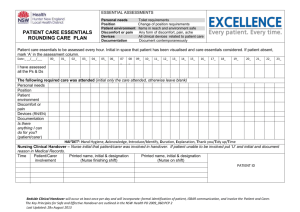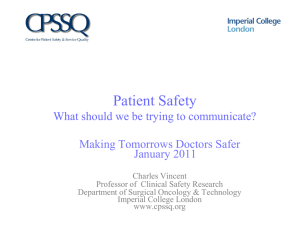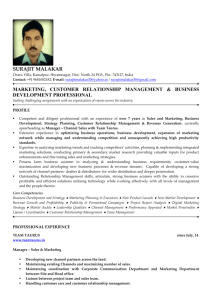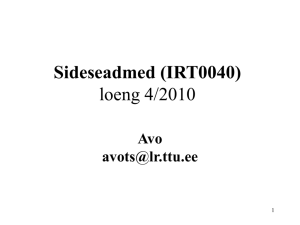A Fuzzy Predictive Handover Mechanism based on MIH Links
advertisement
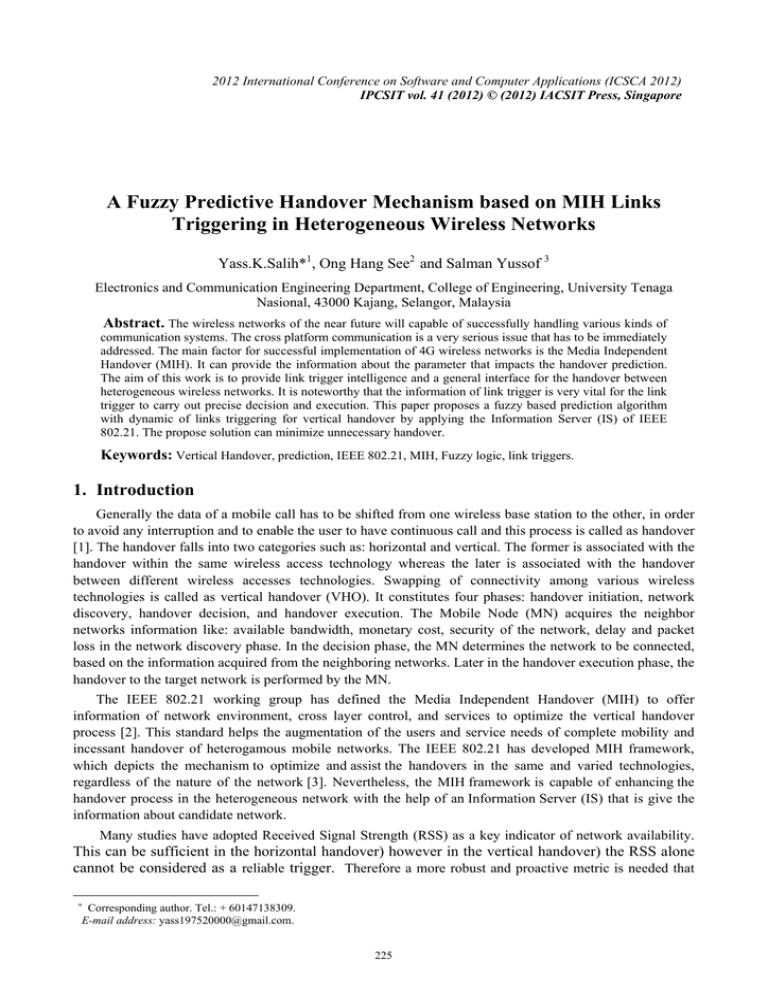
2012 International Conference on Software and Computer Applications (ICSCA 2012) IPCSIT vol. 41 (2012) © (2012) IACSIT Press, Singapore A Fuzzy Predictive Handover Mechanism based on MIH Links Triggering in Heterogeneous Wireless Networks Yass.K.Salih*1, Ong Hang See2 and Salman Yussof 3 Electronics and Communication Engineering Department, College of Engineering, University Tenaga Nasional, 43000 Kajang, Selangor, Malaysia Abstract. The wireless networks of the near future will capable of successfully handling various kinds of communication systems. The cross platform communication is a very serious issue that has to be immediately addressed. The main factor for successful implementation of 4G wireless networks is the Media Independent Handover (MIH). It can provide the information about the parameter that impacts the handover prediction. The aim of this work is to provide link trigger intelligence and a general interface for the handover between heterogeneous wireless networks. It is noteworthy that the information of link trigger is very vital for the link trigger to carry out precise decision and execution. This paper proposes a fuzzy based prediction algorithm with dynamic of links triggering for vertical handover by applying the Information Server (IS) of IEEE 802.21. The propose solution can minimize unnecessary handover. Keywords: Vertical Handover, prediction, IEEE 802.21, MIH, Fuzzy logic, link triggers. 1. Introduction Generally the data of a mobile call has to be shifted from one wireless base station to the other, in order to avoid any interruption and to enable the user to have continuous call and this process is called as handover [1]. The handover falls into two categories such as: horizontal and vertical. The former is associated with the handover within the same wireless access technology whereas the later is associated with the handover between different wireless accesses technologies. Swapping of connectivity among various wireless technologies is called as vertical handover (VHO). It constitutes four phases: handover initiation, network discovery, handover decision, and handover execution. The Mobile Node (MN) acquires the neighbor networks information like: available bandwidth, monetary cost, security of the network, delay and packet loss in the network discovery phase. In the decision phase, the MN determines the network to be connected, based on the information acquired from the neighboring networks. Later in the handover execution phase, the handover to the target network is performed by the MN. The IEEE 802.21 working group has defined the Media Independent Handover (MIH) to offer information of network environment, cross layer control, and services to optimize the vertical handover process [2]. This standard helps the augmentation of the users and service needs of complete mobility and incessant handover of heterogamous mobile networks. The IEEE 802.21 has developed MIH framework, which depicts the mechanism to optimize and assist the handovers in the same and varied technologies, regardless of the nature of the network [3]. Nevertheless, the MIH framework is capable of enhancing the handover process in the heterogeneous network with the help of an Information Server (IS) that is give the information about candidate network. Many studies have adopted Received Signal Strength (RSS) as a key indicator of network availability. This can be sufficient in the horizontal handover) however in the vertical handover) the RSS alone cannot be considered as a reliable trigger. Therefore a more robust and proactive metric is needed that + Corresponding author. Tel.: + 60147138309. E-mail address: yass197520000@gmail.com. 225 not only gives the current status of network coverage availability but it can also predict the during of the coverage and availability of the probable network services. This knowledge is important in the handover initiation process during vertical handover, as it can at a very early stage allow the MN to take important decisions on matters of resource allocation and QoS management. This paper focuses in the handover initiation and tries to find a new predictive link trigger mechanism to avoid unnecessary handover which is essential issue in the vertical handover process. The reminder of the paper is sectioned as follows: In Section 2 the previous work of handover prediction in the heterogamous network. In Section 3, we explain the predictive factors and the issue that handover prediction based on it. In Section 4, we propose fuzzy based prediction algorithm with dynamic link triggering for vertical handover. In Section5, implementation details of propose approach. Finally, in Section 6, we present the conclusion. 2. Related Work Many researchers have focused mainly on the influence of MIH services in handover (decision and execution) process which describes the decision and mobility management solution. Until now not much focus has been given on exploring the problems associated with the MIH itself. The absence of predictive mechanism in the MIH, prior to the handover process. Other researchers who discuses the prediction mechanism can be summarized as follows. Inwhee Joe and Min Chul Shin [4] proposed a mobility based prediction algorithm with dynamic Link Going Down (LGD) triggering for VHO by applying the IS of MIH. Jung et al. [5] proposed an efficient VHO scheme to allow the MN to handover between mobile WiMAX and WLAN networks. Yoo et al. [6] discussed Timely effective handover mechanism using MIH primitives in heterogeneous wireless networks. The same researchers in [7] proposed a new predictive link trigger mechanism using a least mean square (LMS) linear prediction for seamless VHO networks. With assist of the neighbor network information that obtained from MIH IS. Yousaf et al, [8] presented an intelligent model for generating MIH LGD trigger reliably . Liu et al. [9] proposed a new method to estimate when a device needs to take practical actions and prepare handovers. Liu et al. [10] introduced a novel proficient triggering scheme to predict when a device requires to carryout proactive actions and prepare for handovers. With the smart triggering, events such as LGD might be predicted more than 1second ahead of time. Popovici et al, [11] presented a new predictive mechanism to describe video streaming application build to evaluate our prototype system. 3. Prediction Factors and Corresponding Issues 3.1. Prediction Factors Usually a conventional horizontal handover algorithm is accomplished with the help of received signal strength (RSS) measurement. However in the case of vertical handover, RSS measurement cannot make an optimal decision in the vertical handover initiation phase. While performing a vertical handover, other parameters must be taken into account such as available bandwidth (ABW) and type of service [12]. For instance, during the change over of services from voice to video, it is better to employ a new network that has high data rate and it must be checked whether the network is capable of handling the new service. In this case, handover prediction is necessary to be triggered. As a result, link quality (RSS) and Quality of Service (QoS) (ABW, service type) requirement of service to be the prediction factors. From this example, it can be observed that more prediction factors are necessary to be considered during network prediction. 3.2. Media Independent Handover (MIH) For the purpose of optimizing the handover process among heterogeneous networks, the IEEE 802.21 standard [3] articulates a middleware architecture constituting a cross layer communication protocol and three services such as: Event Services (ES), Command Services (CS) and Information Service (IS) that aids handovers across heterogeneous networks (see figure 1). These services are administered and organized by a fourth service known as the management service. Based on the primordial of the service management, the MIH function is able to discover other MIHF entities [13]. 226 Fig. 1: The MIH reference model [13]. Media Independent Event Service is the service offered by MIHF, which informs about amendments in the local and remote link layer properties in the form of link events or triggers. These triggers include i) Link Down (LD), ii) Link Up (LU), iii) Link Going Down (LGD), iv) Link Going Up (LGU), etc. Prediction of this possible connectivity is based on the past and present conditions of link parameters. In Information Service (IS) we can collect the information about the parameters that effect on the handover detection such as RSS, ABW and service type that is recorded for mobile terminal which in neighboring network, then vertical handover procedure will be accomplished efficiently by using the information obtained from IS . 4. The Propose Algorithm for VHO Prediction Under the IEEE 802.21 [2] media independent handover function (MIHF) shown in Figure 2, current network connecting with the terminal can easily collect the useful information of its neighboring networks (WiFi, WiMAX, and UMTS) by registering for MIH services. Most of the information is dynamic, changing with time such as RSS and ABW. Current network sends the dynamic information request to neighboring networks, after it identifies that the link between itself and the terminal is going down and the handover is about to be triggered. So the current network can collect them as soon as it senses the new neighboring network or any other time, and store them in its own database. Unlike the dynamic ones, some information is static such as service types available in a network. Fig. 2: Block Diagram of Proposed System. The Fuzzy Inference System consists of fuzzifier, fuzzy inference engine, fuzzy rule base and defuzzifier [7]. Here in this research, sing fuzzifier and fuzzy rule base. In fuzzification converting the crisp values into variables and then defining membership function (mf) for each parameter as shown in table 1 and table 2. Table 1. Membership Functions Membership Functions Low Medium High Available Unavailable Value 1 2 3 4 5 227 Table 2. Membership Functions of Variables Low medium High Received Signal Strength (RSS) RSS<60db 60 < =RSS <90db RSS =>90 db Available bandwidth(ABW) ABW< 0.2 0.2 < ABW < 0.37 ABW > 0.37 Service type Unavailable (U) Available (A) The technology is not support for this The technology is support to this service service Rules Evaluation are evaluated by combination of three inputs, there are 18 possible rules, available bandwidth and received signal strength, using three (3) mf’s and two mf’s for service type. And output is given by numbers from 1 to 18 in preference of lower to higher. This output is stored in files for further processing. In File saving the state of the last evaluated interface is written in a file, and then it is compared with the already evaluated interface. The comparator read the states of different networks from file and then compare those with each other to get the better one. Events from different layers are generated depending on the comparator output. As shown in table 3 the possible rule for LGD and LGU are 2 from 18 also for LU is 1 from 18 in other side the possible rule for LD are 13 from 18 in this case no need to do handover process because the requirement of technology not enough in term of RSS or QoS. Table 3. Possible rules with output event generation 5. Our Propose Approach This section elucidates the efficiency of the propose predictive link-trigger handover mechanism. The figure 3 illustrates the simulation handover scenario, where vertical handovers among of three radio interfaces UMTS, WiMAX and WiFi are considered. The MN can obtain the neighbor networks information from a handover Information Server (IS) using the IEEE 802.21 information service function. It is implicated that the predictive handover accrued in the handover initiation phase to avoid unnecessary handover before the handover decision and execution process. At point (A), the MN is in UMTS network running some data application. The link trigger status for UMTS is link UP (LU) while for both Wimax and WiFi are Link down (LD). As it is moving toward point (B), it enters in WiMax coverage area and detects Link Up trigger and it shifts to WiMax network, because it is better than UMTS in QoS (bandwidth), while WiFi still Link Down (LD). After sometimes it comes in the range of Wi-Fi network where there is point (C), the UMTS link is going down (LGD) in terms of RSS and QoS, while WiMAX still Link UP and WiFi becomes link up (LU), now the flow is redirected to Wi-Fi network because WiFi is better in term of available bandwidth. 228 Fig. 3: Vertical Handover Scenario. 6. Conclusion This paper had proposed a predictive link triggering mechanism for seamless handover in heterogeneous wireless networks. The IEEE 802.21 standard helps the neighbour network topology to carry out information exchange in terms of network conditions, and handover policies prior to the handover process, hence it is probable to obtain the necessary predictive handover in advance. The proposed predictive link trigger mechanism could be successively applied to IEEE 802.21 media independent handover architecture. The proposed system can reduce needless handover based on the useful information that obtained from MIH IS. 7. References [1] K.Savitha, C.Chandrasekar," Trusted Network Selection using SAW and TOPSIS Algorithms for Heterogeneous Wireless Networks ", International Journal of Computer Applications, (0975 – 8887) Volume 26– No.8, 2011. [2] Claudio Cicconetti, Francesco Galeassi, and Raffaella Mambrini, "Network-Assisted Handover for Heterogeneous Wireless Networks", IEEE Globecom Workshop on Seamless Wireless Mobility, 978-1-4244-8865-0, 2010. [3] Pedro Neves, Joao Soares, Susana Sargento, Hugo Pires, and Francisco Fontes, "Context-aware media independent information server for optimized seamless handover procedures ", ScienceDirect, Computer Networks 55, 2011. [4] Inwhee Joe and MinChul Shin, "A Mobility-based Prediction Algorithm with Dynamic LGD Triggering for Vertical Handover",IEEE Communications Society,2010. [5] Bo Yle Jung, Min Seok Choi, and Hee Y ong Youn, Ohyoung Song, " Vertical Handover based on the Prediction of Mobility of Mobile Node", Pervasive Computing and Communications Workshops (PERCOM Workshops), 2010 8th IEEE International Conference. [6] Sang-Jo Yoo, David Cypher, Nada Golmie, “Timely Effective Handover Mechanism in Heterogeneous Wireless Networks”, Proceedings of the Springer Wireless Personal Communications, 2010. [7] Sang-Jo Yoo, David Cypher, Nada Golmie, “Predictive Link Trigger Mechanism for Seamless Handovers in Heterogeneous Wireless Networks”, Wireless Communications & Mobile Computing, 2009. [8] M. Yousaf, Sohail Bhatti, Maaz Rehan, A. Qayyum, and S. A. Malik,” An Intelligent Prediction Model for Generating LGD Trigger of IEEE 802.21 MIH” ICIC'09 Proceedings of the 5th international conference on Emerging intelligent computing technology and applications,2009. [9] Huaiyu Liu, Christian Maciocco, and Vijay Kesavan, “Using Predictive Triggers to Improve Handover Performance in Mixed Networks”, Springer, 2008. [10] Huaiyu Liu, Christian Maciocco, Vijay Kesavan, and Andy Low,” A Smart Triggering Scheme to Reduce Service Interruption during Heterogeneous Handovers”, International Conference on Dependable Systems & Networks, Alaska, 2008. [11] Eduard C. Popovici, Valentin Andrei, Mihai Gavrilescu, Mihnea A. Magheti,” Video Streaming for Evaluation of Predictive VHO in Wireless Hybrid Access Networks” , TELSIKS International Conference,2011. [12] Ying Wang, Lei Zheng, Jun Yuan, Wensheng Sun, “Median Based Network Selection in Heterogeneous Wireless Networks” WCNC'09 Proceedings of the 2009 IEEE conference on Wireless Communications & Networking Conference. [13] Manzoor Ahmed Khan, Umar Toseefy, Stefan Marx, and Carmelita Goerg, "Auction based Interface Selection with Media Independent Handover Services and Flow Management", IEEE European wireless Conference,2010. 229



